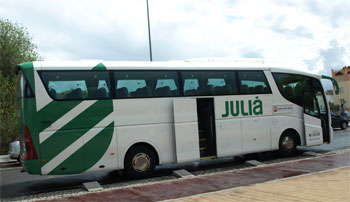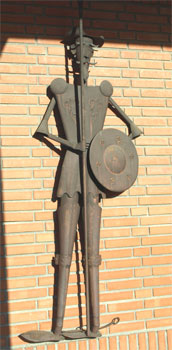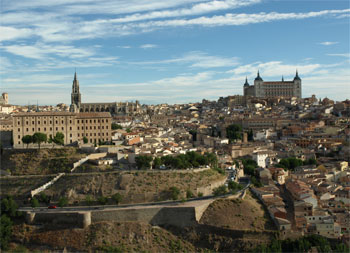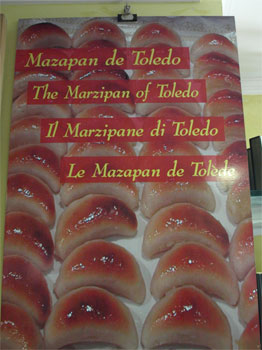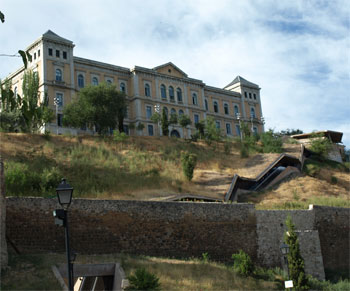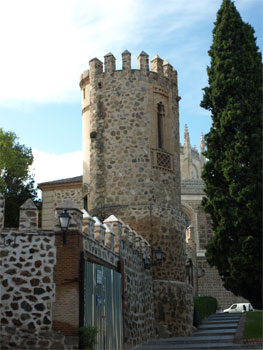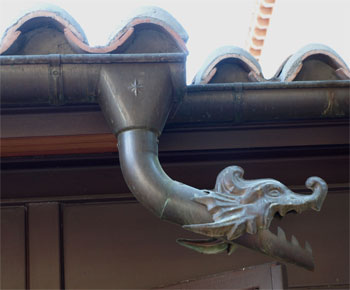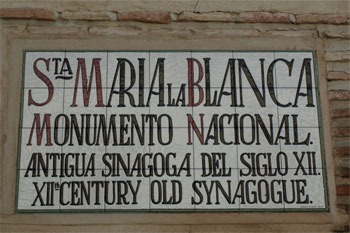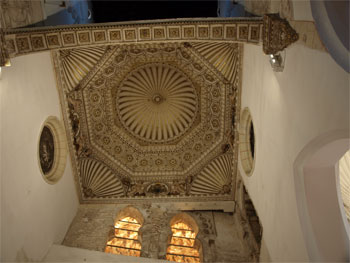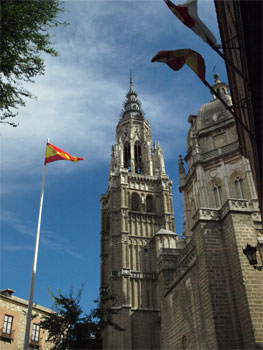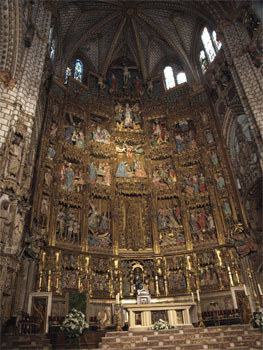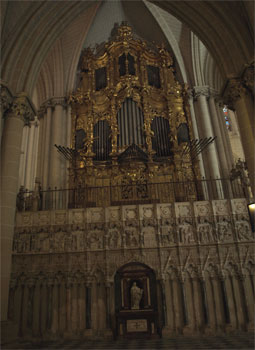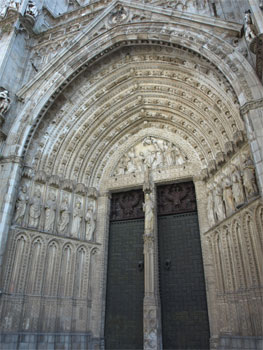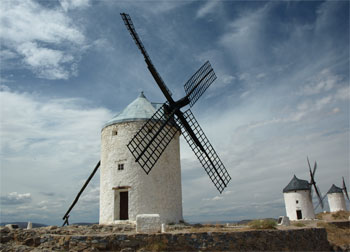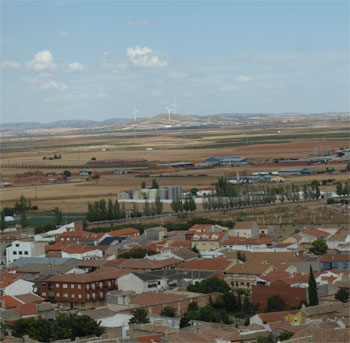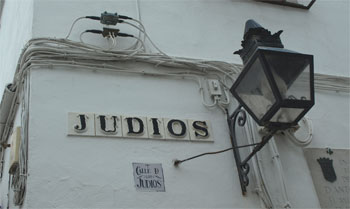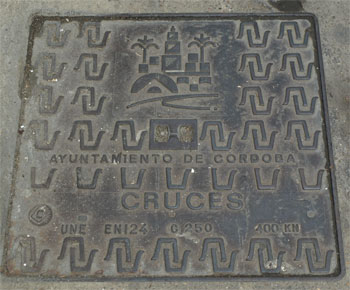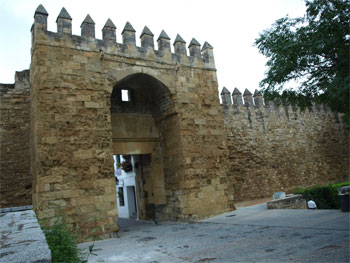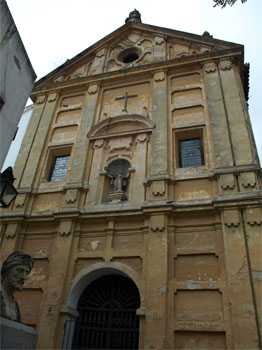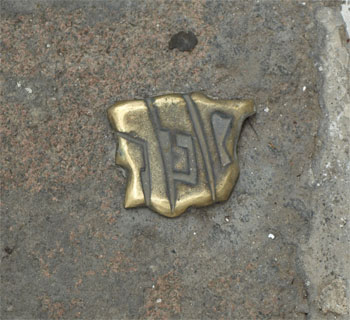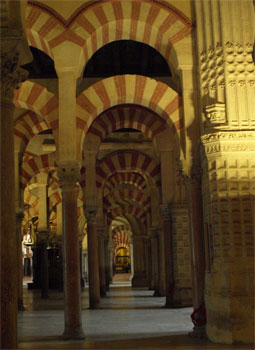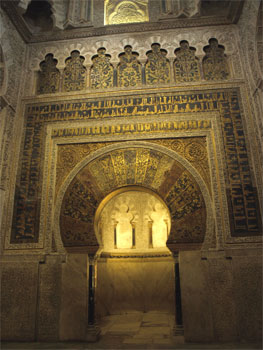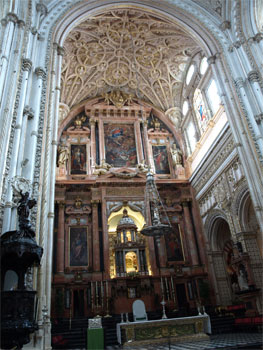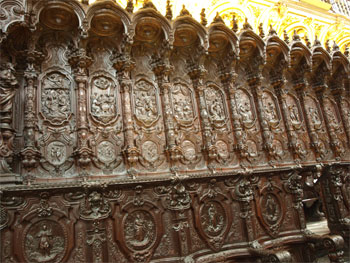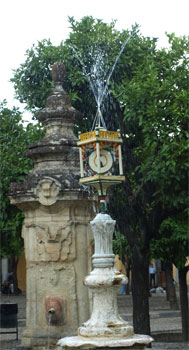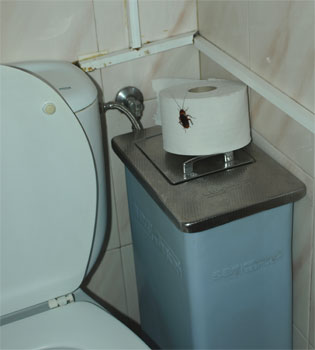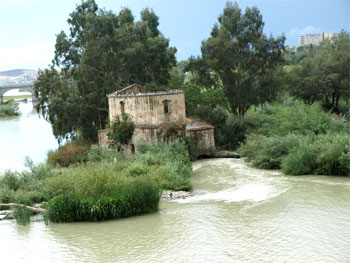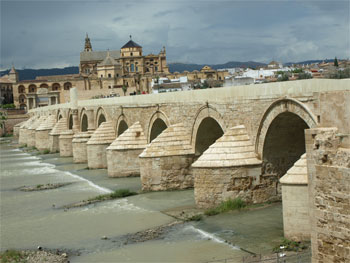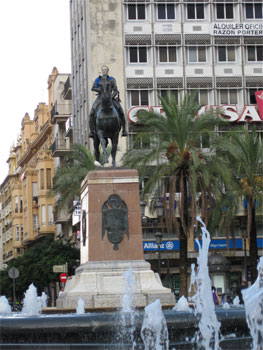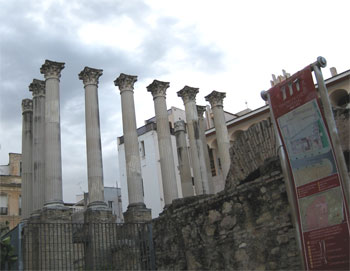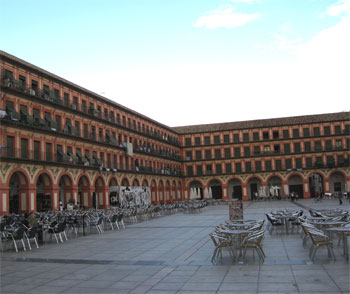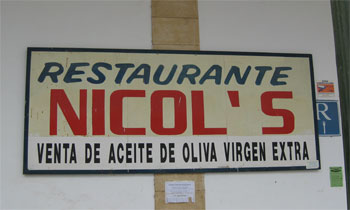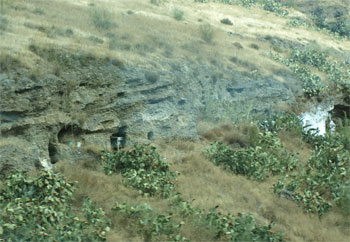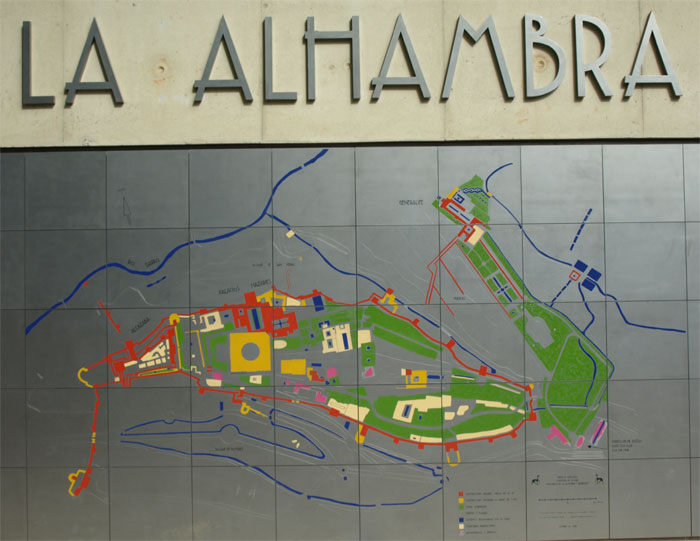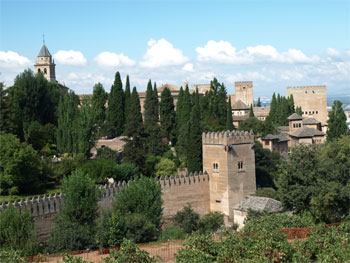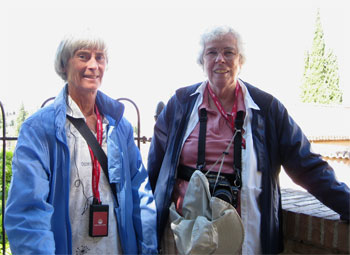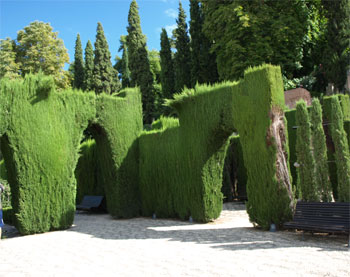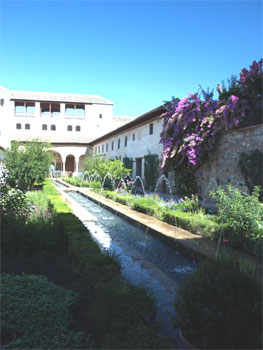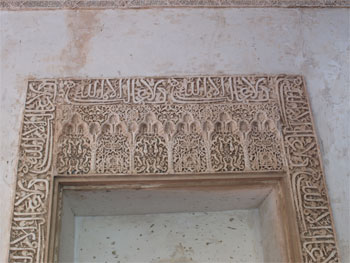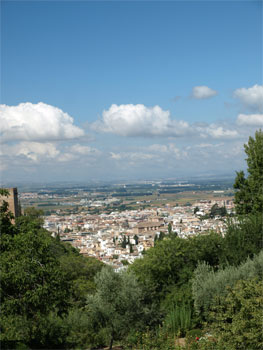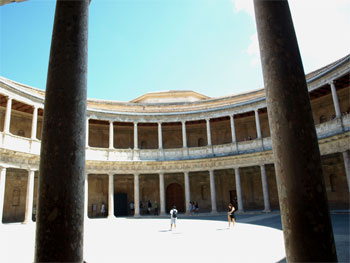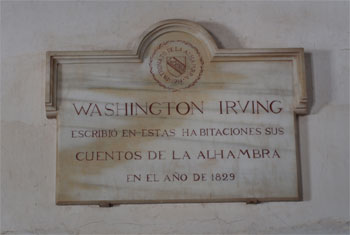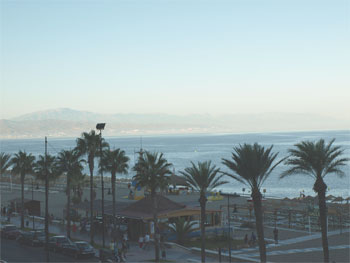Thurs., 9/1/11 - Madrid, Toledo, & Cordoba
This morning we got up early and packed up to leave Madrid at 8 AM. An hour away we toured medieval Toledo, another UNESCO World Heritage Site. It was the capital of Spain until the 16th c. It sits on a hill overlooking the Tagus River. We stopped at an overlook and could easily see El Alcazar, the 16th c. Moorish citadel and the Toledo Cathedral. We looked down on olive and almond trees. The area here is known for making marzipan - almond paste and sugar.
Julia - our chariot for our tour of Spain and Portugal |
Don Quixote - on the wall at a comfort stop
|
Toledo from the hill across the Tagus River - Cathedral of Toledo to the left and Alcazar (fortress) on the right |
Marzipan sign
|
We entered the section of the city that once was the Jewish Quarter. To get there we rode up several escalators to take us from the bus drop-off point to the inside of the old city of Toledo. We entered the walls through the entrance gate of the Jews. The Jews lived in Toledo from 75 BC to 1492 in peace with Romans, Arabs, and Christians until Ferdinand decided they had to convert to Catholicism or leave. They left, but many supposedly kept the keys to their homes and businesses with plans to return. They have not returned.
|
|
Foreground - series of escalators to the old city at the top of the hill
|
Tower
|
Neat downspout
|
We entered the oldest synagogue in Spain. It was in use at least by 1196. It looks like a Mosque because it was built by the Moors. Women and children prayed from the balcony but the tabernacle faced Mecca, as well as Jerusalem. There is a cross at the front now and only one Star of David remains.
|
Sign outside old synagogue |
Synagogue interior
|
Synagogue interior
|
Streets made for walking - carefully
|
We entered the Church of the Apostle Thomas (San Tome) that contains one of El Greco's masterpieces, The Burial of Count Orgaz. No pictures, of course. It really is something to see such famous works of art. Next we visited the Cathedral of Toledo, the seat of the Bishop. The building was begun in 1226 and was finished in 1493. The paintings, altars, carvings, statuary, and windows are elaborate and magnificent. There are 10 organs in the cathedral including the oldest one in Spain. We entered the sacristy and looked at the private collection of 19 more El Greco paintings, most from his black period (depressing). The ceiling, by Luca Giordano, might have been painted like the Sistine Chapel and the end wall is El Expolio by El Greco. The original elaborate gilded wood frame was used for firewood and only a small section has been recovered. On the way out we peeked into a few side rooms of the sacristy, which displayed 15th to 17th c. bishop's robes, miters, chalices, etc. They were opulent!
|
|
Cathedral of Saint Mary of Toledo
|
Cathedral of Saint Mary of Toledo |
Cathedral of Saint Mary of Toledo
|
Cathedral of Saint Mary of Toledo |
Back on the bus we headed south toward Cordoba. We stopped at a small town, Consuegra, in the region (or state) of La Mancha. On the hill above the town are 14 remaining 200-year old windmills.
|
|
La Mancha district
|
Windmills of La Mancha |
Windmills and Castle of Conseugra |
Town of Conseugra with modern windmills in the distance
|
Our city walking tour began this morning in the old Jewish quarter. There were once again three religions and cultures living together peacefully until the inquisition around 1492 that forced people to convert or leave. We entered the once walled city through a typical 2200-year-old Roman gate and visited a very small 14th c. synagogue, the "only medieval one left in Spain." In 1492 it began its next life as a church (a cross painted on the wall is apparent) then a hospital, a school, and now an historical site.
Old Jewish quarter |
Sewer cover with the emblem of Cordoba
|
2200-year old Roman gate
|
Medieval synagogue |
Street scene
|
Building
|
There are many statues in small squares here and there. One was of Maimonides and another of Mohamed Al-Gafequi, the Arab surgeon who first did cataract surgery in the 8th c. We have seen brass Hebrew letters, a sefarad, placed among some of the street paving stones. These signified a Jew lived/worked there.
|
Maimonides
|
Mohamed Al-Gafequi
|
Sefarad set in street |
The main purpose of our stay in Cordoba was to visit the Mezquita (the Great Mosque) built in the 8th to 10th centuries. Five times the building was enlarged to its present size - which is huge. Outside is the ablution square with trees planted in place of the spigots. The bell tower replaced the minaret and a high alter was built in the center of the prayer room in the 16th c. converting the mosque to its present state of a cathedral - the Cathedral of Cordoba.
|
|
Bell tower of the Cathedral of Cordoba
|
Cathedral interior with pillars and arches from the time when it was the Great Mosque
|
Al-Hakam II’s mihrab - a niche (in simple mosques) which indicates the direction of Mecca |
Cathedral interior - side altar
|
Carved wood choir stalls |
16th century gold monstrance
|
Cathedral window |
Exterior side door of the Cathedral
|
Court of Oranges
|
Not everything is always perfect |
Behind the mosque are the 2000-year-old bridge and the remains of three watermills that once ground flour for the city. There is a monument to the city patron, the Archangel Rafael.
|
|
Arch of Triumph
|
Grist mill |
2000-year old Roman bridge
|
Later in the day we met the group and walked into the old city to Tendillas Square - the Times Square of Cordoba - with its fountains and a bronze statue of Gonzalo Fernandez de Cordoba, the Grand Capitan, who fought off the Moors in this area of Spain. Winning soccer teams celebrate at this square but haven’t had a victory for 25 years! We passed the ruins of a 1st c. Roman temple. It was uncovered when they started a building expansion of the city hall. |
Statue of Gonzalo Fernandez de Cordoba in Tendillas Square
|
Roman Temple ruins |
Plaza de la Corredera
|
We ended our walk at the Plaza de la Corredera, which was once (17th c.) where bullfights were held and heretics were burned at the stake. It was structured much like the Plaza Mayor in Madrid. It is now all shops and residential apartments.
|
Saturday, 9/3/11 – Cordoba – Granada – Costa del Sol, Spain
On the way to Granada and the Alhambra, we had a pit stop in Cuque at an old “stage coach” stop. The place gave us samples of local olive oil, jasmine scented olive oil, hand cream, almonds, and nougat.
Stop at Cuque |
Olive press
|
On the way up the windy rocky road to the Alhambra citadel we saw many house caves. All we could see were doors in the rock and maybe a car parked along side. Gypsies live in these caves and pay no taxes but get electricity and water. Gypsies are often apparent on the streets. They hold rosemary branches and try to read your palm for money.
Gypsy house caves
|
The last Moorish sultan in Spain lived in the Alhambra (which means fortress) in two palaces and with 300 wives. In 1492 Ferdinand and Isabella had the sultan sign his surrender in his own throne room and the next day, in the same room, she gave permission to Columbus to take three ships and sail west.
|
The Generalife is the elongated green space to the right and the Alhambra itself is the large walled (in red) area in the center and left of the map.
|
|
Our tour started at the Generalife, the sultan's summer palace that is across a ravine from the fortress that is the Alhambra. It was higher up the hill and surrounded by vegetable and herb gardens. He spent daytime here but always returned to the fortified palace below at night. He rode a horse the 100 yards from one to the other.
|
|
The Alhambra as seen from the Generalife
|
Our "we were there" picture |
The Generalife has many Arabic courtyards making part of the house an outdoor open area. The rooms have typical Arabic carved stucco walls with words from the Koran and intricate wood carved ceilings. From this hillside we looked out over all of the Alhambra and Granada beyond.
|
Gardens of the Generalife
|
Gardens of the Generalife
|
Arabic carving in the Generalife |
View of Granada from the Generalife
|
Hillside and wall (left of center) viewed from the Generalife |
"Facilities" for the Generalife
|
We had tickets to visit the Alhambra at a certain time. Only so many tickets are sold each day and only 50 people at a time are let in. We had to have our tickets scanned five times on the tour. The Alhambra is designed as three buildings. The first area was for justice, the second for political functions like meeting dignitaries, and the third was the living quarters for the sultan on the first floor and his 300 concubines on the second floor. Each section had courtyards and beautiful arches, walls, and ceilings. (No indoor pictures were allowed.) Connecting this political area to the palace living quarters were some rooms added in 1829 for Washington Irving to live in and write. The rooms had fireplaces. The Arabs used charcoal burners for heat.
|
Interior courtyard
|
Washington Irving sign |
After lunch it was onward for the long ride to Torremolinos of the Costa del Sol - the Sun Coast of Spain.
Our hotel in Torremolinos is across the street from the beach on the Mediterranean. There is a nice pedestrian promenade and a cute little touristy beach town. We stopped at a "mercado" and bought things for an evening snack.
|
Beach and the Mediterranean from our hotel
|
Street scene in Torremolinos |
Sunrise
|
| Return to Top | Return to Itinerary | Return to Dreamcatcher Home Page |
